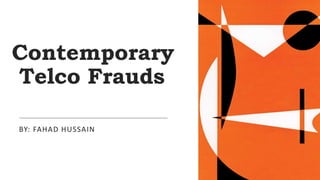
Contemporary Frauds.pptx
- 1. Contemporary Telco Frauds BY: FAHAD HUSSAIN
- 2. Telecommunications Fraud? Telecommunications fraud also known as telco fraud or telecom fraud. Telecommunications fraud represents a serious threat to the telecommunication industry. It refers to the abuse of telecom products or services with the intention of illegally acquiring money from a communication service provider or its customers. It includes any kind of action intended to abuse and gain a benefit over telecommunications businesses using fraudulent practices.
- 3. How Does Telecommunications Fraud Work? Fraud attacks usually evolve quickly over time as companies squash them, telco fraud is unique as it’s often taken as a given. Its costs are absorbed by operators, who would rather not embark on integrating complex risk management systems into their architectures. There are several ways that fraudulent calls/messages and data usage occur. These include providing unrestricted access for making outbound calls/SMS, contracting with a fraudulent individual/business or agreeing to standard post payment terms, which provides the scammer with unlimited credit until detected.
- 4. Types of Telecommunications Fraud Seven key fraud trends have been identified that telcos should take into account when planning their fraud management strategy . 1. A2P Traffic Fraud 2. Grey Traffic Fraud 3. International Revenue Sharing Fraud 4. Telecom Arbitrage Fraud 5. Subscription Fraud 6. Account Takeover 7. Wangiri Fraud
- 5. A2P Traffic Fraud Illegal SMS routing to the mobile operator’s network. International SMS traffic can be routed through the connection points of several transit operators, where each operator charges a fee for SMS termination. Illegal SMS routing bypasses the agreed connection points, which is fraudulent. SMS aggregators receiving traffic from OTT services can use illegal routes to terminate SMS on the networks of mobile operators The receiving SMS operator loses income, since it does not charge a mobile termination fee. SMS Bypass fraud leads to downtime of the operator’s active network, where the planned volume of SMS traffic does not come to the network
- 6. Grey Traffic Fraud Calls from foreign countries are brought in the country as local calls while using illegal means One of the most successful telecom fraud is “Grey calling route” which bypasses the licensed carriers by terminating international calls onto domestic telecom networks through unlicensed and illegal telecom set ups. A telecom subscriber in a foreign country originates an ISD voice call to Pakistan. To bypass charges payable to LDI operator in Pakistan, the foreign fraudulent carrier routes the call over the internet to an illegal voice over IP Gateway and SIMbox placed in Pakistan. The VOIP Gateway and SIMBox utilize high speed internet connection to divert VOIP based ILD calls through a Mobile/Fixed connection to a called party which receives an international call with a Pakistani Mobile Number, or No Number displayed on the Handset.
- 7. International Revenue Sharing Fraud Making unauthorized calls to premium numbers. Using fraudulent access to an Operators network to artificially inflate traffic to numbers obtained from an International Premium Rate Number Provider, for which payment will be received by the Fraudster on a revenue share basis with the number provider for every minute of traffic generated into those numbers. Fraudster generates calls to Premium destinations while using network services like Call Forwarding and Conferencing to generate overlapping and simultaneous calls to maximize revenues. Fraudster continues this activity until the Network detects and blocks the number range. Fraudster will then move to another Fraudulent access and continue calling additional numbers.
- 8. Telecom Arbitrage Fraud General practice of capitalizing on price differences Telecom arbitrage is often considered to be a fraudulent activity that exploits differences in long- distance rates between countries. Just like international bypass fraud, it can lower the international cost for customers, but also open the door to fraudulent companies who insert themselves between operators. Fraudulent companies claim to connect directly from country A to B, whereas, in fact, they go through a cheaper rate country to connect the call. The risk of arbitrage fraud has increased due to the possibility of fraudsters earning a payout per minute on revenue share numbers higher than the retail costs of the voice calls and SMS.
- 9. Subscription Fraud Subscription fraud occurs when a fraudster uses their own, a stolen or a synthetic identity to obtain mobile services or devices with no intention to pay. As the wholesale and retail purchase cost of devices has increased over recent years, a grey market has been created and exploited by fraudsters obtaining devices to resell for lucrative profits. Fake subscribed SIMs are sold at a very high price in the grey market and these sims are then used in various fraudulent and criminal activities.
- 10. Account Takeover A form of identity theft Telecom companies who offer online user accounts can be victims of ATO attacks, where fraudsters find the login and password details of other users and sign in in their place. Then the fraudster makes non-monetary changes to account details such as: Modifies personally identifiable information The identity thief may use your information to apply for credit, file taxes, or get medical services. These acts can damage your credit status and cost you time and money.
- 11. Wangiri Fraud A Japanese word meaning 'one (ring) and cut' Wangiri telecommunications fraud involves striking curiosity in customers by calling them, letting the phone ring once, and hanging up. The customer will often ring back, unwillingly calling an expensive premium number that the fraudsters control. To the user, the CLI (caller number ID) is modified in such a way that it looks like a genuine call and when the victim calls back, it turns out to be a premium rate service (PRS) number owned by fraudster for which the victim is charged heavily for the calls. The fraudster intends to keep the victim on hold to increase the billed amount. The premium rate service provider pays the fraudster a certain share of the call revenue for each minute of call received by the premium rate number